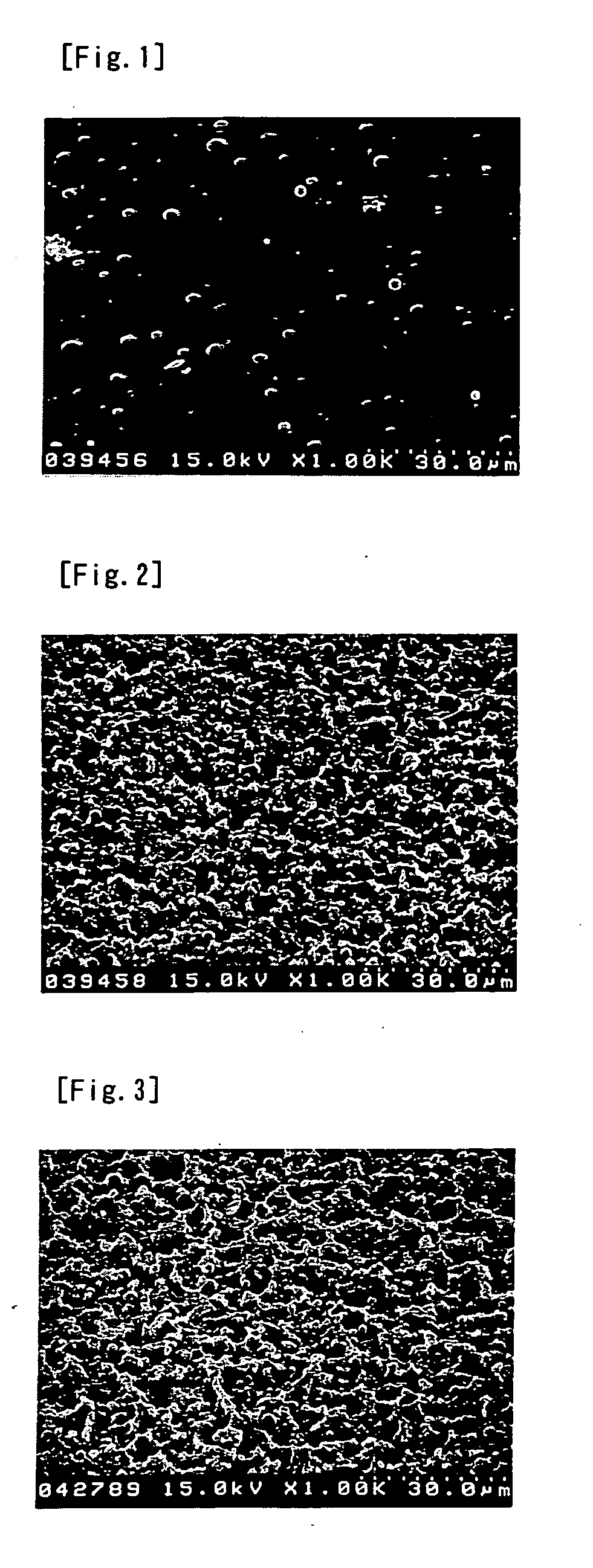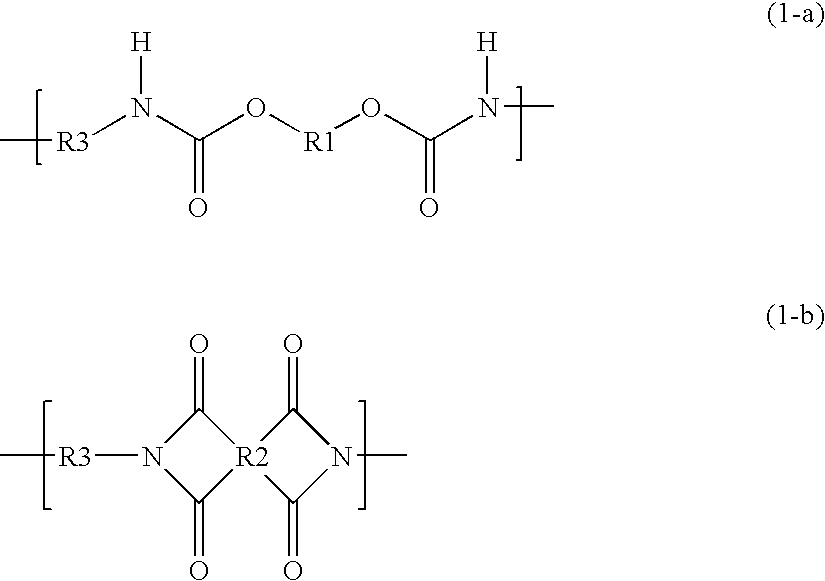Thermosetting resin composition containing modified polyimide resin
a technology of modified polyimide resin and composition, which is applied in the direction of printed circuit, printed circuit manufacturing, printed circuit aspects, etc., can solve the problems of high cost and not always preferred methods, difficult handling in the production step of using ultrathin copper foil, and high cost of precision vacuum apparatus, etc., and achieves poor laser processing properties and high elastic modulus.
- Summary
- Abstract
- Description
- Claims
- Application Information
AI Technical Summary
Benefits of technology
Problems solved by technology
Method used
Image
Examples
production example 1
Production of Modified Linear Polyimide Resin (Modified Linear Polyimide Resin Varnish A)
[0147] In a reaction vessel, 50 g of G-3000 (a bifunctional hydroxyl-terminated polybutadiene, number average molecular weight=5047 (GPC method), hydroxyl equivalent=1798 g / eq., solid content=100% by weight, available from Nippon Soda Co., Ltd.); 23.5 g of IPSOL 150 (an aromatic hydrocarbon-based mixed solvent available from Idemitsu Kosan Co., Ltd.); and 0.005 g of dibutyltin laurate were mixed and dissolved uniformly. The uniform mixture was heated to 50° C., and 4.8 g of toluene-2,4-diisocyanate (isocyanate equivalent=87.08 g / eq.) was added thereto, and the resultant mixture was reacted for approximately 3 hours while stirring. The reaction mixture was subsequently cooled to room temperature, thereto were added 8.96 g of benzophenone tetracarboxylic dianhydride (acid anhydride equivalent=161.1 g / eq.), 0.07 g of triethylenediamine, and 40.4 g of ethyl diglycol acetate (available from Daicel C...
production example 2
Production of Modified Linear Polyimide Resin (Modified Linear Polyimide Resin Varnish B)
[0148] In a reaction vessel, 50 g of G-3000 (a bifunctional hydroxyl-terminated polybutadiene, number average molecular weight=5047 (GPC method), hydroxyl equivalent=1798 g / eq., solid content=100% by weight, available from Nippon Soda Co., Ltd.); 23.5 g of IPSOL 150 (an aromatic hydrocarbon-based mixed solvent available from Idemitsu Kosan Co., Ltd.); and 0.007 g of dibutyltin laurate were mixed and dissolved uniformly. The uniform mixture was heated to 50° C., and 4.8 g of toluene-2,4-diisocyanate (isocyanate equivalent=87.08 g / eq.) was added thereto, and the resultant mixture was reacted for approximately 3 hours while stirring. The reaction mixture was subsequently cooled to room temperature, thereto were added 8.83 g of benzophenone tetracarboxylic dianhydride (acid anhydride equivalent=161.1 g / eq.), 0.07 g of triethylenediamine, and 74.09 g of ethyl diglycol acetate (available from Daicel ...
example 1
[0149] 40 parts of a component (A) of the modified linear polyimide resin varnish A obtained in Production Example 1, 8 parts of a component (B) of a bisphenol A type epoxy resin (epoxy equivalent: 185, “EPIKOTE 828” available from Japan Epoxy Resins Co., Ltd.), and 6.5 parts of a methyl ethyl ketone (hereinafter referred to as MEK) varnish of a triazine structure-containing phenol novolac resin (“PHENOLITE LA-7054” available from Dainippon Ink and Chemicals, Inc.) were mixed to prepare a varnish of a thermosetting resin composition. The thermosetting resin composition was subsequently applied by a die coater to a release-treated polyethylene terephthalate (hereinafter referred to as PET) film having a thickness of 38 μm such that the composition had a resin thickness of 70 μm after drying. The applied composition was dried at 80 to 120° C. (100° C. on average) for 6 minutes to form a thermosetting resin composition layer having a residual solvent content of approximately 1% by weig...
PUM
| Property | Measurement | Unit |
|---|---|---|
| Percent by mass | aaaaa | aaaaa |
| Percent by mass | aaaaa | aaaaa |
| Percent by mass | aaaaa | aaaaa |
Abstract
Description
Claims
Application Information
 Login to View More
Login to View More - R&D
- Intellectual Property
- Life Sciences
- Materials
- Tech Scout
- Unparalleled Data Quality
- Higher Quality Content
- 60% Fewer Hallucinations
Browse by: Latest US Patents, China's latest patents, Technical Efficacy Thesaurus, Application Domain, Technology Topic, Popular Technical Reports.
© 2025 PatSnap. All rights reserved.Legal|Privacy policy|Modern Slavery Act Transparency Statement|Sitemap|About US| Contact US: help@patsnap.com



